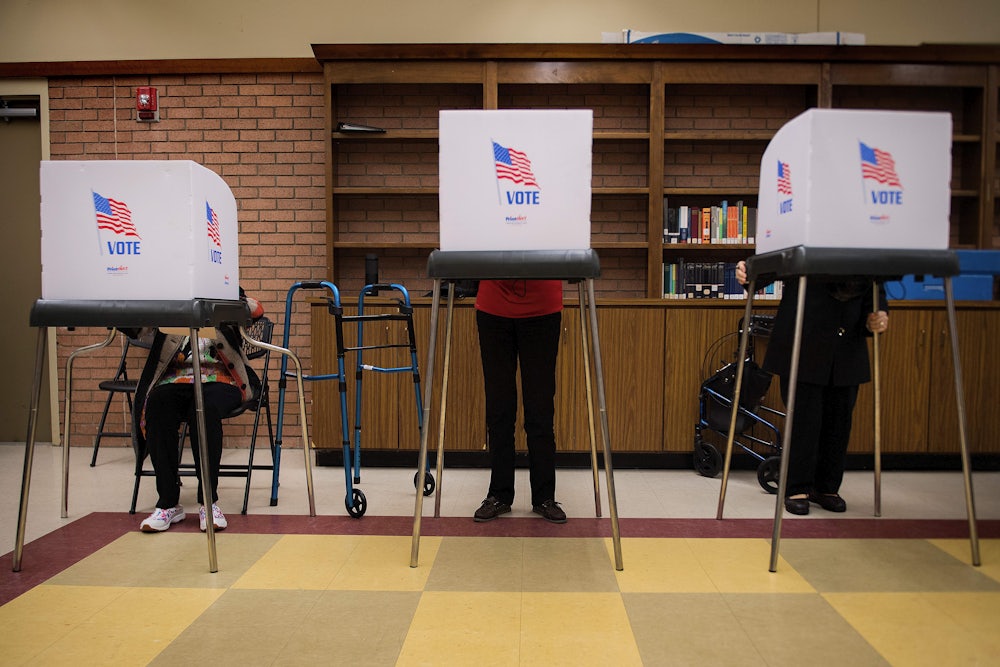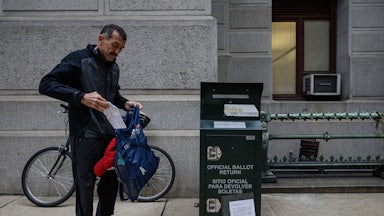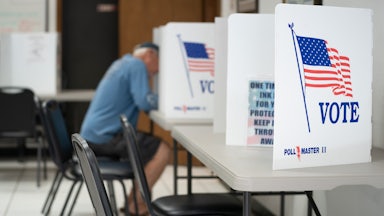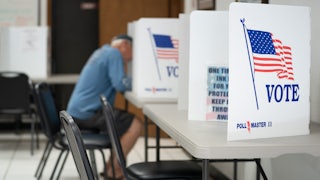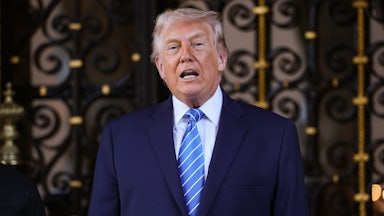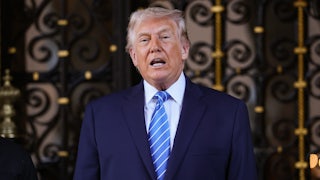President Joe Biden declared last week that democracy is on the ballot in this week’s midterm elections. While he and many news outlets are rightly focusing on election deniers and other undemocratic candidates, that doesn’t tell the complete picture. Millions of Americans won’t have much of a say in how the House, Senate, or key statewide races will affect the republic, as I noted last week. But millions of others will have the opportunity to weigh in on that question directly through ballot initiatives at the state level across the country.
Perhaps the most prominent reform for voters to consider this year is ranked-choice voting, or RCV. Instead of voting for one candidate for a single seat or office, voters in a RCV system rank each of the candidates on the ballot in order of their preference. When the ballots are first counted, each voter’s first-place choice counts as a single vote for that candidate. The candidates who receive the fewest votes are eliminated, and the ballots are counted again. During the next round, voters whose ballots listed an eliminated candidate first are recounted using their second-place choice. The eliminations typically continue until a candidate has attained a majority of the vote.
RCV is currently used in Maine and Alaska, which adopted the system in 2020 and earlier this year respectively. Maine adopted the system in time for the 2020 election without any complications (though the state does not use it for presidential contests). Alaska adopted the RCV method that year and first used it this summer in a special election to fill the state’s sole House seat. The winner of that race, Democratic Representative Mary Peltola, will be up for reelection under the same method against three other candidates—two Republicans and one Libertarian—who also received the most votes in the nonpartisan primary.
Nevada, the only state where RCV is on the ballot this year, would adopt a system that is largely similar to Alaska’s. If Question 3 passes, the state would replace the current partisan primary system with a nonpartisan primary election, where the top five candidates from any party would advance to the general election, where ranked-choice voting would determine the ultimate winner. Like Maine and unlike Alaska, Nevada would not use the RCV method for presidential elections.
Some U.S. cities, including Seattle, Portland, Oregon, and a handful of other municipalities and localities, are also holding referenda on whether to implement ranked-choice voting. RCV is already in use in some major cities like New York City and San Francisco, reflecting a growing willingness among some voters to experiment with different electoral systems for more competitive and representative elections. That trend could be tested in a year where conservative voters may be ascendant. A local news outlet poll in August found a 15-point lead among RCV supporters in Nevada but also that roughly one-third of likely voters hadn’t made up their mind yet on the question.
Michigan, which became one of the key electoral battlegrounds in 2020, is considering a measure that would entrench and expand reforms in how voters cast a ballot in that state. Proposal 2, if enacted, would allow for nine days of early in-person voting, mandate drop boxes for absentee ballots, and allow military and overseas ballots to be counted as long as they are postmarked by Election Day, among other things. Some of these rules are already part of state law and would become permanent if added to the state constitution; others are altogether new.
Some provisions in Michigan’s initiative are also a response to the 2020 presidential election and its aftermath: Proposal 2, for example, would only allow election officials to audit election results and require local canvassing boards only to use the official record of votes cast to certify the results. A Michigan county board made national headlines in 2020 when its two Republican members briefly refused to certify results that would have helped award the state to President Joe Biden. And with an uncomfortable eye to the present and future, it would also establish a right to vote without facing “harassing, threatening, or intimidating conduct.”
Alabama is also considering a state constitutional amendment on elections in response to the 2020 election, but in the opposite direction. Amendment 4 would forbid the state legislature from making changes to election laws within six months of voting in a state and federal election. Republicans in the state legislature championed the measure earlier this year as a response to election-law changes made ahead of the 2020 election that were implemented in many states to ensure voters could still safely exercise their right to vote during the Covid-19 pandemic. Former President Donald Trump and his allies have partially blamed those measures for his reelection defeat that year.
Some proposed electoral reforms are aimed at preventing other potential reforms from happening. Voters in two states, Louisiana and Ohio, will consider statewide requirements that would allow only U.S. citizens to vote in their state and local elections. While it is illegal under federal law for noncitizens to cast a ballot in federal races, it’s up to the states to decide whether they can vote for state and local offices. No state explicitly allows noncitizens to vote at the moment, though some states permitted it in the nineteenth century and early twentieth century. But some states have no laws that forbid it, either, giving some U.S. municipalities an opening to allow it in their local elections.
Proponents of noncitizen voting have argued that adopting the practice makes a community’s elected leadership more representative by giving every resident a voice, regardless of their citizenship status or nationality. I argued against D.C.’s noncitizen voting bill last month by noting that it violates basic principles of self-government and would effectively create a second-class tier of citizenship. Four other states—Alabama, Colorado, Florida, and North Dakota—have banned the practice outright in ballot initiatives over the last four years by roughly 2-to-1 margins. Those numbers suggest that while conservative voters make up the bulk of the measures’ support, restricting the vote to U.S. citizens has appeal across partisan and ideological lines.
The two most potentially significant ballot measures for democracy reform this year are also the two least likely to succeed. Some state constitutions require that voters be given the opportunity to vote for or against a state constitutional convention at regular intervals, usually every 10 or 20 years. Three states—Alaska, Missouri, and New Hampshire—will vote on that this week. But in two of those states, support for a constitutional convention appears to be slim.
The Kansas City Star’s editorial board urged Missourians in August to reject the question, citing bipartisan opposition and warning that the process could be abused by partisan figures and by wealthy donors. “An unbounded convention could wreak havoc on important parts of the state constitution, then present it to voters as an up-or-down proposal,” the newspaper warned. “The Missouri Constitution is a mess, but wholesale changes are too risky.” In New Hampshire, where voters overwhelmingly opposed redrafting the state constitution when they last considered it in 2012, it appears to be a marginal issue at most this time. New Hampshire Secretary of State David Scanlan told NHPR that he wasn’t aware of any organized campaigns for or against it.
Alaska is a different story. This time, there’s a host of prominent conservative officials who support an affirmative vote on calling a state constitutional convention, including Governor Mike Dunleavy. My colleague Grace Segers reported last month that some proponents are driven in part by hopes to change the state’s judicial selection process and give the authority to appoint state Supreme Court justices to the governor. That change, they hope, would make it harder for abortion rights supporters to win legal challenges at the state level in a post-Roe world. But not all of the opposition or support is defined by abortion rights, and a kaleidoscope of interest groups and state political figures have lined up on both sides of the question.
In a year when Americans are taking stock of their democracy and voting accordingly, it makes sense that at least some voters would consider changes to how their government works. In some states, that could mean technical tweaks to election laws and voting procedures. In Alaska, that might look like a wholesale revision of the state’s foundational charter. Americans will vote on what they want their country to look like this November. In these races, they will also vote on something that might be even more consequential: how Americans decide these questions in the first place.
